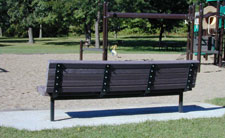Parks Abound with Plastic Lumber
Plastic Lumber in Midwest Parks
EPA530-F-03-030
July 2003

Much to their delight, two state parks in the Midwest have discovered the long-term benefits of recycled plastic lumber as a construction material. In Indiana and Minnesota, structures made from recycled milk jugs are proving to be an environmentally preferable—and economic—alternative to wood products.
To celebrate Earth Day 1995, Harmonie State Park in Indiana built a viewing platform and four bridges from plastic lumber. The lumber was made from 150,000 recycled milk jugs, all collected from Indiana residents, and the project was funded in part by a General Electric employees’ charity group. The plastic lumber project not only supported Indiana’s recycling industry, but provided a durable replacement for pressure-treated wood, which had come under scrutiny in the park for its potential to emit chemicals into the air and water.
“The Indiana Department of Natural Resources has found recycled plastic lumber to be superior to treated wood lumber for certain applications because it is impervious to insects, does not rot or splinter, can be easily cleaned, and does not need to be stained or painted over time,” said John Bergman of Harmonie State Park. “The savings in maintenance costs make up for the initial cost of the lumber.”

In Anoka County, Minnesota, recycled plastic lumber has replaced wooden tables and benches in parks across the county, following a successful regional park pilot project conducted in 1995. Minnesota’s Office of Environmental Assistance initially funded plastic lumber picnic tables, benches, tire stops, planters, park signs, landscape edging, and a playground in Lake George Regional Park to test the quality of recycled-content products.
According to Mike Jacobson of Anoka County, although each plastic lumber picnic table cost Anoka County $330 (versus a $150 wooden table), the plastic models are more durable than wood. The wood tables traditionally last 1 or 2 years in the park before they begin to rot and incur graffiti damage, but plastic doesn’t rot, and graffiti is easily removed. “If someone carves on the plastic, we melt plastic shavings over the divots to erase the carving,” he said. “Unlike on wood, if pens or markers are used, we can rub it out of the plastic with a cleaner.” The plastic lumber benches are so successful that Jacobson doesn’t think they will need to be replaced in his lifetime!
View and print this fact sheet (PDF) (1 pg, 97K, about PDF)
Disclaimer: Reference herein to any specific commercial products, process, or service by trade name, trademark, manufacturer, or otherwise, does not necessarily constitute or imply its endorsement, recommendation, or favoring by the United States Government. The views and opinions of authors expressed herein do not necessarily state or reflect those of the United States Government, and shall not be used for advertising or product endorsement purposes.
![[logo] US EPA](../gif/logo_epaseal.gif)